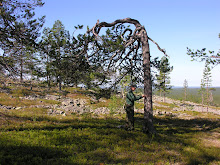I finally left my thesis for inspection yesterday – and today starts my long awaited Christmas holiday. So wrapping up the thesis summary really took the whole autumn. It is rumored that PhD thesis summaries have been written in a couple of days, and even in reality some of us manage to make it a couple of weeks. I started the summary already in June, so I had plans to finish the summary at latest in October. Then there would have been some time for free research. The free time diminished to just two days, but at least the work was finished before my 4-year GSForest scholarship ends at 31 December.
How was the time spent then? Reading the literature. Recalculating some results that were presented differently in the sub-studies. Compiling the yet unpublished results. Writing – I decided not to copy-paste very much from the sub-studies, so most of the text is new. And finally, corrections. I was quite satisfied with the first draft, but the supervisor comments helped to make it much better. Still, there is at least one error in the submitted summary, and probably more that I’m not aware of. It is interesting to see what the pre-examiners find!
Some time was also spent on other things, including the Silvilaser conference trip, teaching, seedling inventory project, and the last sub-study, which was happily accepted right before I returned the summary. So although the autumn was busy and the deadlines moved ahead several times, looking back now I think that it went quite well. But the next year will be even more interesting…
Happy holidays!















